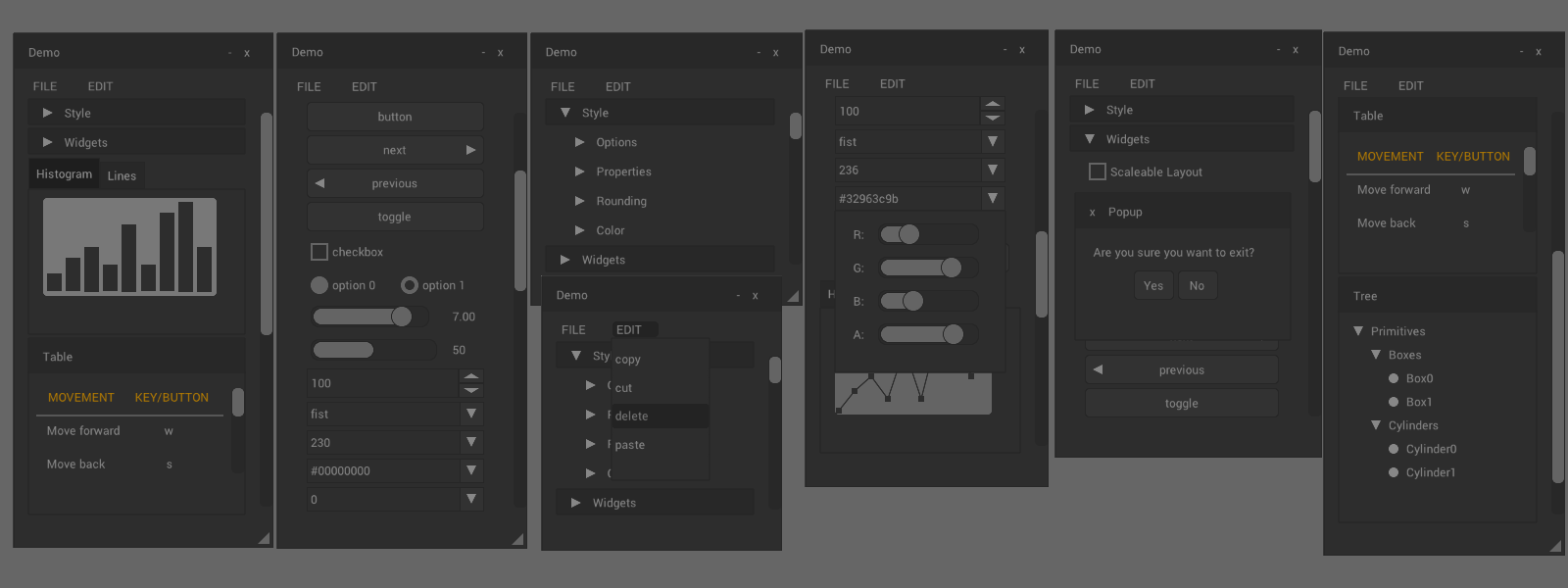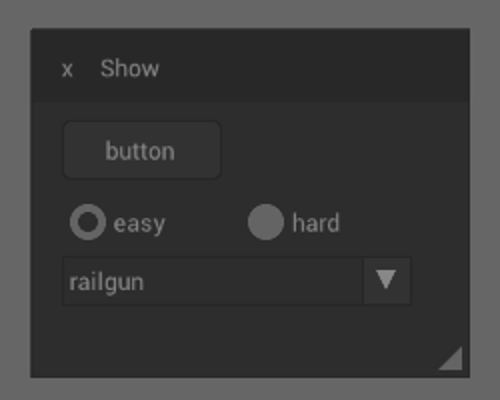| demo | ||
| screen | ||
| gui.c | ||
| gui.h | ||
| LICENSE | ||
| Readme.md | ||
GUI
This is a bloat free minimal state immediate mode graphical user interface toolkit written in ANSI C. It was designed as a simple embeddable user interface for application and does not have any direct dependencies.
Features
- Immediate mode graphical user interface toolkit
- Written in C89 (ANSI C)
- Small codebase (~7kLOC)
- Focus on portability, efficiency, simplicity and minimal internal state
- No global or hidden state
- No direct dependencies (not even libc!)
- Configurable style and colors
- UTF-8 support
Gallery
Example
/* allocate memory to hold the draw commands */
struct gui_command_queue queue;
void *memory = malloc(MEMORY_SIZE);
gui_command_queue_init_fixed(&buffer, memory, MEMORY_SIZE);
/* setup configuration */
struct gui_font font;
struct gui_style style;
font.userdata.ptr = your_font_data;
font.height = your_font_data.height;
font.width = your_font_string_width_callback_function;
gui_style_default(&style, GUI_DEFAULT_ALL, &font);
/* initialize panel */
struct gui_window panel;
gui_window_init(&panel, 50, 50, 220, 180,
GUI_PANEL_BORDER|GUI_PANEL_MOVEABLE|GUI_PANEL_SCALEABLE,
&queue, &style, &input);
/* setup widget data */
enum {EASY, HARD};
gui_size option = EASY;
gui_size item = 0;
gui_state active = 0;
struct gui_input input = {0};
while (1) {
gui_input_begin(&input);
/* record input */
gui_input_end(&input);
/* GUI */
struct gui_context context;
gui_begin(&context, &panel);
{
const char *items[] = {"Fist", "Pistol", "Railgun", "BFG"};
gui_header(&context, "Show", GUI_CLOSEABLE, 0, GUI_HEADER_LEFT);
gui_layout_row_static(&context, 30, 80, 1);
if (gui_button_text(&context, "button", GUI_BUTTON_DEFAULT)) {
/* event handling */
}
gui_layout_row_dynamic(&context, 30, 2);
if (gui_option(&context, "easy", option == EASY)) option = EASY;
if (gui_option(&context, "hard", option == HARD)) option = HARD;
gui_label(&context, "Weapon:", GUI_TEXT_LEFT);
gui_combo(&context, items, LEN(items), &item, 20, &active);
}
gui_end(&context, &panel);
/* draw */
const struct gui_command *cmd;
gui_foreach_command(cmd, &queue) {
/* execute draw call command */
}
gui_command_queue_clear(&queue);
}
IMGUIs
Immediate mode in contrast to classical retained mode GUIs store as little state as possible by using procedural function calls as "widgets" instead of storing objects. Each "widget" function call takes hereby all its necessary data and immediately returns the through the user modified state back to the caller. Immediate mode graphical user interfaces therefore combine drawing and input handling into one unit instead of separating them like retain mode GUIs.
Since there is no to minimal internal state in immediate mode user interfaces, updates have to occur every frame which on one hand is more drawing expensive than classic retained GUI implementations but on the other hand grants a lot more flexibility and support for overall layout changes. In addition without any state there is no duplicated state between your program, the gui and the user which greatly simplifies code. Further traits of immediate mode graphic user interfaces are a code driven style, centralized flow control, easy extensibility and understandability.
Input
The gui_input struct holds the user input over the course of the frame and
manages the complete modification of widget and panel state. To fill the
structure with data over the frame there are a number of functions provided for
key, motion, button and text input. The input is hereby completly independent of
the underlying platform or way of input so even touch or other ways of input are
possible.
Like the panel and the buffer, input is based on an immediate mode API and
consist of an begin sequence with gui_input_begin and a end sequence point
with gui_input_end. All modifications can only occur between both of these
sequence points while all outside modification provoke undefined behavior.
struct gui_input input = {0};
while (1) {
gui_input_begin(&input);
if (/*mouse moved*/)
gui_input_motion(&input, mouse.x, mouse.y);
if (/*key pressed*/)
gui_input_key(&input, key, gui_true);
if (/*key released*/)
gui_input_key(&input, key, gui_false);
if (/*mouse button pressed*/)
gui_input_button(&input, mouse.x, mouse.y, gui_true);
if (/*mouse button released */)
gui_input_button(&input, mouse.x, mouse.y, gui_false);
gui_input_end(&input);
}
Configuration
The gui toolkit provides a number of different attributes that can be
configured, like spacing, padding, size and color.
While the widget API even expects you to provide the configuration
for each and every widget the panel layer provides you with a set of
attributes in the gui_config structure. The structure either needs to be
filled by the user or can be setup with some default values by the function
gui_config_default. Modification on the fly to the gui_config struct is in
true immediate mode fashion possible and supported.
struct gui_style {
gui_float rounding[GUI_ROUNDING_MAX];
struct gui_vec2 properties[GUI_PROPERTY_MAX];
struct gui_color colors[GUI_COLOR_COUNT];
};
In addition to modifing the gui_style struct directly the styleration API
enables you to temporarily change a property or color and revert back directly
after the change is no longer needed. The number of temporary changes are
limited but can be changed with constants GUI_MAX_COLOR_STACK and
GUI_MAX_ATTRIB_STACK.
gui_style_push_color(style, GUI_COLORS_PANEL, 255, 0, 0, 255);
gui_style_push_attribute(style, GUI_ATTRIBUTE_PADDING, 10.0f, 5.0f);
/* use the styleuration data */
gui_style_pop_attribute(style);
gui_style_pop_color(style);
Since there is no direct font implementation in the toolkit but font handling is
still an aspect of a gui implementation, the gui_font struct was introduced. It only
contains the bare minimum of what is needed for font handling.
For widgets the gui_font data has to be persistent while the
panel hold the font internally. Important to node is that the font does not hold
your font data but merely references it so you have to make sure that the font
always points to a valid object.
struct gui_font {
gui_handle userdata;
gui_float height;
gui_text_width_f width;
};
font.userdata.ptr = your_font_data;
font.height = your_font_data.height;
font.width = your_font_string_width_callback_function;
Memory
Almost all memory as well as object management for the toolkit
is left to the user for maximum control. In fact a big subset of the toolkit can
be used without any heap allocation at all. The only place where heap allocation
is needed at all is for buffering draw calls. While the standart way of
memory allocation in that case for libraries is to just provide allocator callbacks
which is implemented aswell with the gui_allocator
structure, there are two addition ways to provided memory. The
first one is to just providing a static fixed size memory block to fill up which
is handy for UIs with roughly known memory requirements. The other way of memory
managment is to extend the fixed size block with the abiltiy to resize your block
at the end of the frame if there is not enough memory.
For the purpose of resizable fixed size memory blocks and for general
information about memory consumption the gui_memory_info structure was
added. It contains information about the allocated amount of data in the current
frame as well as the needed amount if not enough memory was provided.
/* fixed size queue */
void *memory = malloc(size);
gui_command_queue queue;
gui_command_queue_init_fixed(&queue, memory, MEMORY_SIZE, GUI_CLIP);
/* dynamically growing queue */
struct gui_allocator alloc;
alloc.userdata = your_allocator;
alloc.alloc = your_allocation_callback;
alloc.relloac = your_reallocation_callback;
alloc.free = your_free_callback;
struct gui_command_queue queue;
const gui_size initial_size = 4*1024;
const gui_float grow_factor = 2.0f;
gui_command_queue_init(&queue, &alloc, initial_size, grow_factor);
FAQ
Where is the demo/example code?
The demo and example code can be found in the demo folder. There is demo code for Linux(X11) and nanovg.
Why did you use ANSI C and not C99 or C++?
Personally I stay out of all "discussions" about C vs C++ since they are totally worthless and never brought anything good with it. The simple answer is I personally love C and have nothing against people using C++ especially the new iterations with C++11 and C++14. While this hopefully settles my view on C vs C++ there is still ANSI C vs C99. While for personal projects I only use C99 with all its niceties, libraries are a little bit different. Libraries are designed to reach the highest number of users possible which brings me to ANSI C as the most portable version. In addition not all C compiler like the MSVC compiler fully support C99, which finalized my decision to use ANSI C.
Why do you typedef your own types instead of using the standard types?
This Project uses ANSI C which does not have the header file <stdint.h>
and therefore does not provide the fixed sized types that I need. Therefore
I defined my own types which need to be set to the correct size for each
platform. But if your development environment provides the header file you can define
GUI_USE_FIXED_SIZE_TYPES to directly use the correct types.
Why is font/input/window management not provided?
As for window and input management it is a ton of work to abstract over all possible platforms and there are already libraries like SDL or SFML or even the platform itself which provide you with the functionality. So instead of reinventing the wheel and trying to do everything the project tries to be as independent and out of the users way as possible. This means in practice a little bit more work on the users behalf but grants a lot more freedom especially because the toolkit is designed to be embeddable.
The font management on the other hand is litte bit more tricky. In the beginning the toolkit had some basic font handling but I removed it later. This is mainly a question of if font handling should be part of a gui toolkit or not. As for a framework the question would definitely be yes but for a toolkit library the question is not as easy. In the end the project does not have font handling since there are already a number of font handling libraries in existence or even the platform (Xlib, Win32) itself already provides a solution.
References
- Tutorial from Jari Komppa about imgui libraries
- Johannes 'johno' Norneby's article
- ImGui: The inspiration for this project
- Nvidia's imgui toolkit
License
(The MIT License)



